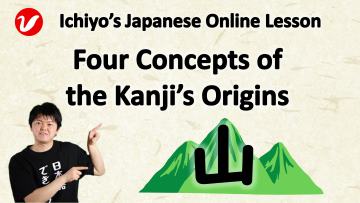We will teach you how kanji characters were created. Please learn the kanji basics through this page.

I’m Ichiyo and I represent “Ichiyo’s Japanese Online Lesson.”
My job is teaching Japanese to non-native Japanese learners.
Ichiyo’s Japanese Online Lesson:
We want learners to have the correct Japanese skills. Therefore, we offer two types of services. One is the private Japanese lesson. The other is the “Daily Japanese Mail Support” service. You can learn Japanese with us anywhere in the world.
Four types of kanji formations
The kanji’s origins are divided into four concepts.
象形文字(しょうけいもじ、shōkei-moji): Pictograms
「象形文字」means “letters transformed into pictograms.”
For example, the kanji 山、火、木、子 are classified as「象形文字 (pictograms)」.
「山」means “mountain.” This is how the kanji「山」was created.

「火」means “fire.” This is how the kanji「火」was created.

「木」means “tree.” This is how the kanji「木」was created.

「子」means “child.” This is how the kanji「子」was created.

山、火、木、子:These kanji characters were created from their forms.
指事文字(しじもじ、shiji-moji): Simple Ideograms
「指事文字」means “characters whose form is based on a logical representation of an abstract idea.”
For example, the kanji 二、上、下 are are classified as「指事文字 (simple Ideograms)」.
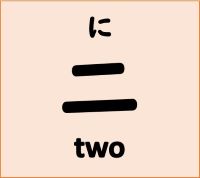
This kanji「二」is read as「に」. It is composed of two lines and means “two.” The origin of this kanji is easy to understand.
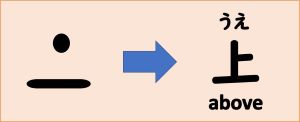
Please look at the image on the left. The dot and the line indicate “above.” This is how kanji「上」was created. 「上」means “above.”
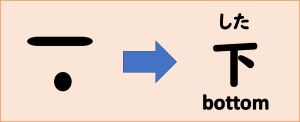
Please look at the image on the left. The dot and the line indicate “bottom.” This is how kanji「下」was created. 「下」means “bottom.”
会意文字(かいいもじ、kaii-moji): Compound Ideograms
These are kanji that are made up of multiple other kanji. We often guess the kanji meaning from the elements.
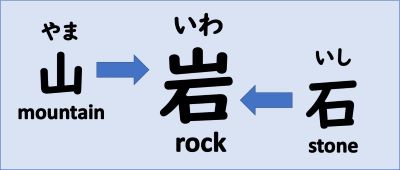
The kanji「岩」is composed of two kanji characters「山」and「石」. 「山」means “mountain” and「石」means “stone.”「山」forms the upper part and the bottom part is composed of「石」.「岩」means “rock.”
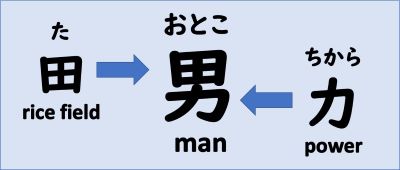
The kanji「男」is composed of two kanji characters「田」and「力」. 「田」means “rice field” and「力」means power.「田」forms the upper part and the bottom part is composed of「力」. 「男」means “man.” Therefore, we can imagine a man working in a rice field when we see this kanji.
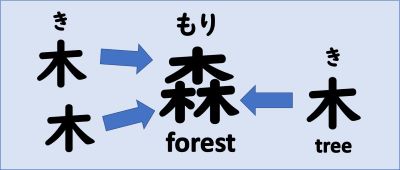
「森」means “forest” and the kanji is composed of three kanji characters「木」. 「木」means “tree.” It is easy to imagine how「森」was created.
形成文字(けいせいもじ、keisei-moji): Phonetic-Ideographic
These are kanji characters which can be divided into two parts. One part shows the rough meaning, and the other part shows the pronunciation.

The kanji「星」can be divided into two parts. One is「日」, the other is「生」. The kanji「日」means “sun” or “day.” The kanji「星」means “star.” The upper part indicates the rough meaning. The sun is similar to a star. The on-reading「生」is「セイ」. The on-reading of「星」is also「セイ」.「生」is the phonetic element of this kanji.
By the way,「星(ほし)」is the kun-reading.
※ 音読み (on-reading) :The original Chinese reading / 訓読み:Japanese reading

The kanji「線」can be divided into two parts. One is「糸」, the other is「泉」. The kanji「糸」means “thread” or “yarn.” The kanji「線」means “wire.” Thread or yarn is similar to wire. The on-reading「泉」is「セン」. The on-reading of「泉」is also「セン」.「泉」is the phonetic element of this kanji.

The kanji「銅」can be divided into two parts. One is「金」, the other is「同」. The kanji「金」means “gold.” The kanji「銅」means “copper.” Gold is similar to copper. The on-reading「同」is「ドウ」. The on-reading of「銅」is also「ドウ」.「同」is the phonetic element of this kanji.
Therefore, the elements of the kanji characters help us understand the kanji.
By the way, I wrote on-readings in katakana. If you don’t know the reason, please ask it through our “Daily Japanese Mail Support” or in our private lesson.

The Video
Our main YouTube channel: Ichiyo’s Japanese YouTube Channel
Our sub-YouTube Channel (Japanese vocabulary videos): Ichiyo’s Subchannel
